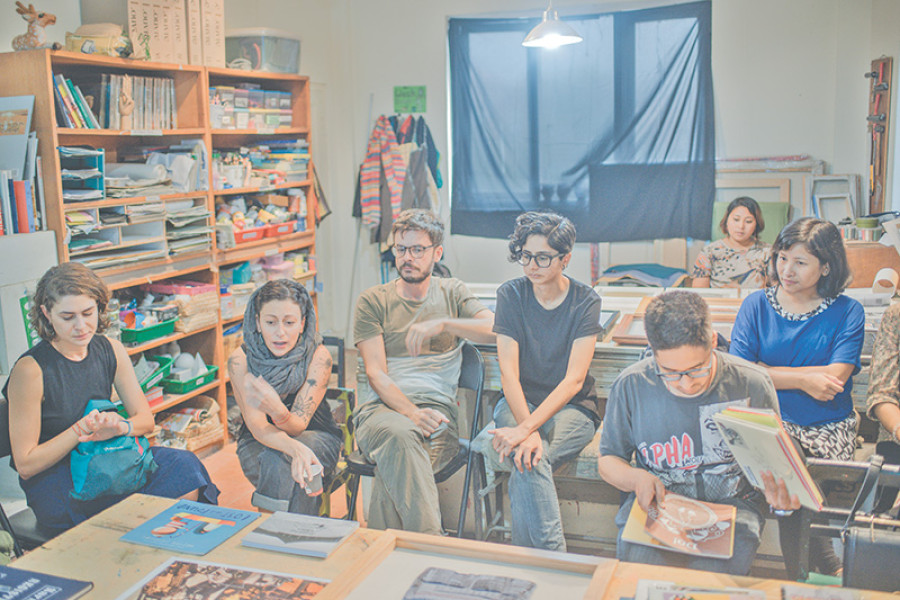Miscellaneous
Cultivating and collaborating
In Mangalbazar, past a honking flood of vehicles, beyond a throng of people and behind the Krishna Mandir, there is a rose-pink structure with a large eyesore of a sign. This is the Yala Heritage Home and inside, on the top floor, is an artistic family. Eight people, representing their own diverse cultures and personalities, have gathered here to plumb the depths, circling the arts, culture, the environment and the people of the valley. These six artists, along with two curators, are part of Photo Kathmandu’s month-long mixed-media residency programme.
Abani Malla
In Mangalbazar, past a honking flood of vehicles, beyond a throng of people and behind the Krishna Mandir, there is a rose-pink structure with a large eyesore of a sign. This is the Yala Heritage Home and inside, on the top floor, is an artistic family. Eight people, representing their own diverse cultures and personalities, have gathered here to plumb the depths, circling the arts, culture, the environment and the people of the valley. These six artists, along with two curators, are part of Photo Kathmandu’s month-long mixed-media residency programme.
Wooden stairs lead me to a kitchen where the artists sit. We gather around a corner table to discuss their experiences so far. The residency consists of two solo artists and two artist duos selected after an international open call for applications. During the length of the residency, September 28 to November 1, they are encouraged to focus on the process of creation, rather than worrying about the output. Curated by Veeranganakumari Solanki and Sujan Chitrakar, the residency acts as a platform to connect the resident artists to the host city and conduct a collaborative artistic effort.
For Valentina Abenavoli from Italy and Ilglin Deniz Akseloglu from Turkey, this residency is fertile space for interaction and a completely new space for them to test themselves in. The artist duo focuses on photography and illustrations, as is evident from the tattoos on Valentina’s arm and Ilgin’s own passion for imagery. As both Valentina and Ilgin come from areas prone to earthquakes, they are eager to explore the effects of 2015’s massive earthquake in Nepal and document their findings. Their plan is to create a three-channel video by collecting visuals of the valley and adding sounds and text effects.
From Pakistan, Fiza Khatri’s approach is different. “What I’m looking at is feminism clear spaces in Kathmandu and how they come together, the kinds of concerns that they have right now and how they relate to society,” she says. As Fiza speaks, I am suddenly not where I was sitting a while ago. Her perspective takes me to the road outside, the one I had just walked to get here. Fiza points how the women here are thriving and are in an open relationship with the streets, compared to back home in Karachi. By exploring feminism, spaces and lifestyles, Fiza plans to visualise what she learns into a series of oil paintings. She is also working on a play, which is more about storytelling through personal narratives in collaboration with a few communities, and to practice improvisation theatre to develop a screenplay.
The artists consider this accompanied experience as an opportunity to explore new aesthetics. Their words reflect the bond they have already developed towards each other’s perspectives. Even the Nepali artists, Nhooja Tuladhar and Bandana Tulachan, say they are now seeing everyday things in a new light. For these artists, collaboration has new meaning, one that I too had not considered before. “This kind of collaboration is more about sharing ideas and imaginations rather than just tools and techniques,” says Nhooja. “When you’re a professional artist, you’re already collaborating with your client to give life to their theoretical ideas,” says Valentina. “But here, we collaborate together to reach our individual goals.”
Nhooja and Bandana share how growing up in the Valley has shaped the foundation of their project. They have been researching and meeting with locals to collect personal stories to showcase digitally. “I have a younger brother who spends more time with technology than with his loved ones,” says Bandana. “While our generation was gifted with stories from our elders, we want to work with technology to rekindle the love of storytelling, especially among the youngsters.”
Meanwhile, Marco Panzetti from Italy, although sick and absent during my meeting with artists, is documenting changes in the Valley especially the air quality. He has been going through the archives, meeting artists who work with traditional art mediums, and taking 360 degree pictures and videos to showcase the differences.
Nhooja and Bandana have always wanted to work together, but the opportunity had eluded them, until now. Many heads nod in agreement when Bandana mentions that this opportunity to collaborate as one of the primary reasons behind why they are part of this residency. Having a space to share and curators to guide their process also provides a medium to gain feedback, references, and help structure ideas. “The collective discussions fuel the creative process and is an integral part of this experience,” says Nhooja. It has been just two weeks since the artists have been living together but they emanate a vibe of being long-time friends. For them, it seems collaboration is not just about creating something together but also about growing with the help of one another.
“This is like we are holding the edge of a thread in a tunnel, chasing it and trying to find the light at the end of it,” says Ilgin metaphorically. “But it doesn’t matter how it ends, as we have already found these friends acting as lights in our life.”
I gather my belongings to take my leave. My bag weighs the same, but my mind is now occupied by new notions and perspectives. Just as the residency artists have expressed, collaboration begins in the mind.




 9.12°C Kathmandu
9.12°C Kathmandu










